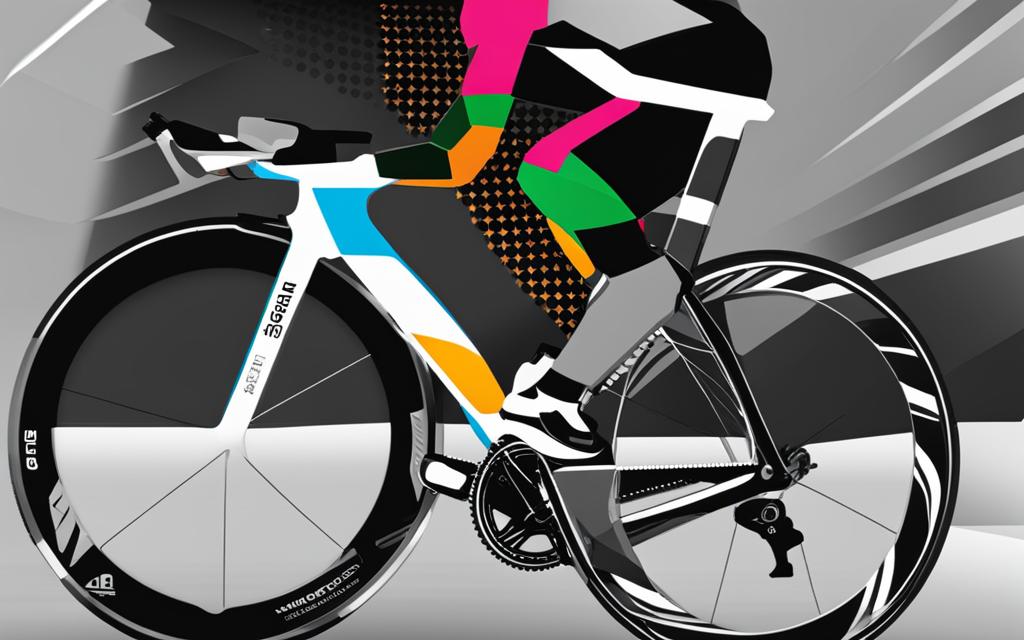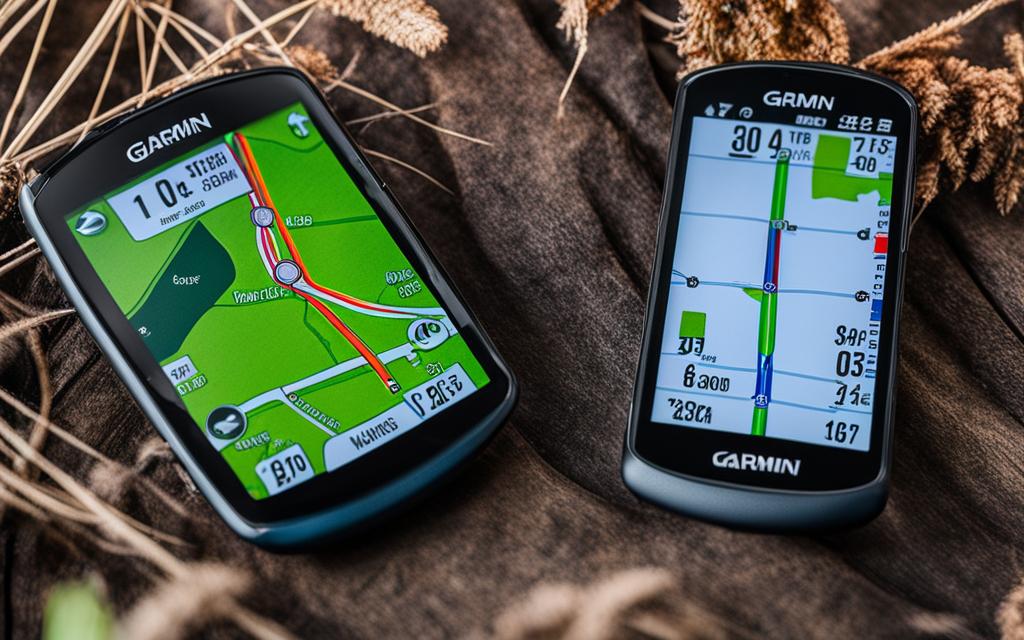As an Amazon Associate, I earn from qualifying purchases
Are you in the market for a top-notch bike GPS device? Look no further than the Garmin Edge 830 and 1030! In this article, we will compare their features to help you decide which one is the perfect fit for your cycling needs.
Key Takeaways:
- The Garmin Edge 830 and 1030 are two of the best bike GPS devices available.
- The main difference is the display size, with the 1030 having a larger screen.
- Both devices offer touchscreens, easy-to-press buttons, and smart navigation features.
- The 830 is smaller and lighter, making it more suitable for daily riding or racing.
- The 1030 has a longer battery life, lasting up to 24 hours on a single charge.
Key Differences between Garmin Edge 830 and 1030
When comparing the Garmin Edge 830 and 1030, several key differences emerge, making each model unique in its own right. Let’s explore these differences in more detail:
Display Size
The most noticeable difference between the Garmin Edge 830 and 1030 is the display size. The Garmin Edge 1030 features a larger 3.5-inch display, providing a more immersive and easy-to-read experience. Meanwhile, the Garmin Edge 830 offers a slightly smaller 2.6-inch display, contributing to its compact and lightweight design.
Battery Life
When it comes to battery life, the Garmin Edge 1030 outperforms the 830. With a battery span of up to 24 hours, the 1030 is ideal for endurance rides and long cycling adventures. In comparison, the Garmin Edge 830 has a slightly shorter battery life of 20 hours, catering to most typical cycling sessions.
Extra Features
In addition to the display and battery life differences, the Garmin Edge 1030 boasts some extra features that set it apart from the 830. The 1030 offers workout suggestions to help you improve your training and performance. It also provides navigation to points of interest, making it easier to explore new routes or find nearby amenities during your ride.
Overall, while the Garmin Edge 830 and 1030 share many similarities, such as touchscreens, smart navigation, and connectivity options, these key differences in display size, battery life, and additional features can influence your decision when choosing the best bike GPS for your needs.
In the next section, we will delve into the similarities between the Garmin Edge 830 and 1030, showcasing their shared functionalities and performance.
| Comparison Points | Garmin Edge 830 | Garmin Edge 1030 |
|---|---|---|
| Display Size | 2.6-inch | 3.5-inch |
| Battery Life | 20 hours | 24 hours |
| Extra Features | No workout suggestions or navigation to points of interest | Offers workout suggestions and navigation to points of interest |
Similarities between Garmin Edge 830 and 1030
Despite their differences, the Garmin Edge 830 and 1030 have many similarities that make them both exceptional bike GPS devices. Here are some of the key features they share:
- Touchscreens: Both the Garmin Edge 830 and 1030 are equipped with easy-to-use touchscreens, allowing for intuitive navigation and effortless interaction with the device.
- Easy-to-press buttons: In addition to touchscreens, both devices have strategically placed buttons that are designed to be easily accessible and responsive, ensuring quick and efficient operation while on the go.
- Smart navigation features: The Garmin Edge 830 and 1030 offer advanced navigation capabilities, allowing cyclists to plan and follow routes, track their progress, and explore new paths with confidence.
- Multi-band GNSS: Both devices utilize multi-band GNSS technology, which ensures accurate tracking and reliable positioning, even in challenging environments with complex satellite signals.
- Crash detection: Safety is a top priority for Garmin, and both the Edge 830 and 1030 come equipped with built-in crash detection capabilities. These devices can detect a potential crash and automatically send alerts to emergency contacts.
- Connectivity options: The Garmin Edge 830 and 1030 offer a wide range of connectivity options, including ANT+, Bluetooth, and Wi-Fi. This allows cyclists to connect their devices to various sensors, accessories, and smartphone apps for a more personalized and enhanced riding experience.
- Mounts included: Both devices come with mounts that securely attach to the handlebars of your bike, providing a stable and convenient way to mount and view your Garmin Edge during your rides.
- Water resistance: When it comes to riding in all weather conditions, both the Garmin Edge 830 and 1030 have got you covered. They are designed to withstand water splashes and light rain, ensuring their durability and functionality in outdoor environments.
With these shared features, the Garmin Edge 830 and 1030 provide cyclists with powerful tools to enhance their riding experience, improve performance, and explore new routes with confidence.
“The Garmin Edge 830 and 1030 offer cyclists advanced features and reliable performance. Whether you’re a casual rider or a competitive cyclist, these devices have the functionality you need to elevate your riding experience.” – Cycling Enthusiast
Explore the similarities and differences between the Garmin Edge 830 and 1030 to find the perfect bike GPS device that meets your specific needs and preferences.

Physical Dimensions & Weight
When considering bike GPS devices, the physical dimensions and weight play a significant role in determining comfort and mobility. In this section, we will compare the physical characteristics of the Garmin Edge 830 and the Garmin Edge 1030.
| Device | Weight | Dimensions (mm) |
|---|---|---|
| Garmin Edge 830 | 79g | 50x82x20 |
| Garmin Edge 1030 | 124g | 58x114x19 |
The Garmin Edge 830 is lighter, weighing 79g, compared to the Garmin Edge 1030, which weighs 124g. This makes the 830 a preferable choice for those who prioritize daily riding or racing, where weight can greatly impact performance. In terms of dimensions, the 830 measures 50x82x20mm, while the 1030 is slightly larger at 58x114x19mm.
With its smaller size and lighter weight, the Garmin Edge 830 offers enhanced portability without compromising on functionality. Whether you’re hitting the trails or participating in a competitive race, the compact design of the 830 ensures a more streamlined and comfortable ride.

Stay tuned for the upcoming sections where we’ll delve into the display comparison and battery life differences between the Garmin Edge 830 and the Garmin Edge 1030.
Display Comparison
The display is a crucial factor to consider when comparing the Garmin Edge 830 and 1030. These two bike GPS devices differ in terms of screen size, which can have a significant impact on the user experience.
The Garmin Edge 1030 boasts a larger 3.5-inch display, providing a more immersive and detailed view of your routes, maps, and data. With its expansive screen real estate, the 1030 delivers enhanced visibility, making it an ideal choice for cyclists who prioritize easy navigation and browsing while riding.
On the other hand, the Garmin Edge 830 features a 2.6-inch display. Although it may be smaller than the 1030’s screen, the 830’s compact form factor can be advantageous for those who value portability and a sleeker design in their bike GPS device.
Whether you opt for the larger screen of the Garmin Edge 1030 or the more compact size of the 830 depends on your personal preferences and priorities as a cyclist.
It’s important to note that both devices offer intuitive touchscreen interfaces, ensuring a seamless and user-friendly experience when interacting with the displays.

Battery Life
When it comes to battery life, the Garmin Edge 1030 outshines its counterpart, the Garmin Edge 830. With an impressive battery life of up to 24 hours on a single charge, the Edge 1030 is perfect for those long rides or multi-day adventures. On the other hand, the Edge 830 offers a still respectable battery life of 20 hours, providing ample power for most cycling excursions.
However, it’s important to note that these battery life estimates are based on specific conditions and may vary depending on individual usage. Factors such as screen brightness, GPS usage, and connected sensors can impact the actual battery life experienced by users.
Ultimately, both the Garmin Edge 830 and 1030 offer substantial battery life to keep you connected and confident during your rides. Choose the one that aligns with your specific needs and ensures you have enough power to explore the roads and trails ahead.
Conclusion
In conclusion, when comparing the Garmin Edge 830 and 1030, it’s clear that both devices offer impressive features and advantages for cyclists. The 1030, with its larger display and longer battery life, is a great choice for those who require extensive navigation and longer rides. On the other hand, the 830’s compact size makes it ideal for cyclists who prioritize portability without sacrificing functionality.
Both models come with advanced features such as touchscreens, smart navigation, multi-band GNSS, crash detection, and various connectivity options. Whether you’re a recreational rider or a professional cyclist, these devices provide valuable data and insights to enhance your riding experience.
Ultimately, the decision between the Garmin Edge 830 and 1030 comes down to your specific needs and preferences. Consider factors such as display size, battery life, and overall portability to determine which device aligns best with your cycling goals. Remember to explore the detailed comparisons of the features and specifications provided in this article to make an informed decision.
FAQ
What are the key differences between Garmin Edge 830 and 1030?
The key differences between Garmin Edge 830 and 1030 are the display size, battery life, and additional features. The Edge 1030 has a larger 3.5-inch display compared to the 2.6-inch display of the Edge 830. The Edge 1030 also has a longer battery life, lasting up to 24 hours, while the Edge 830 has a battery life of 20 hours. Additionally, the Edge 1030 comes with extra features such as workout suggestions and navigation to points of interest.
What are the similarities between Garmin Edge 830 and 1030?
The Garmin Edge 830 and 1030 have several similarities. They both have touchscreens, easy-to-press buttons, and smart navigation features. Both devices also have multi-band GNSS, crash detection, and connectivity options such as ANT+, Bluetooth, and Wi-Fi. They also come with mounts and have the same water resistance rating.
What are the physical dimensions and weight of Garmin Edge 830 and 1030?
The Garmin Edge 830 is smaller and lighter than the 1030. The Edge 830 weighs 79g, while the Edge 1030 weighs 124g. The dimensions of the Edge 830 are 50x82x20 mm, while the Edge 1030 measures 58x114x19 mm.
How do the displays of Garmin Edge 830 and 1030 compare?
The Garmin Edge 1030 has a larger 3.5-inch display compared to the 2.6-inch display of the Edge 830. While the Edge 1030’s bigger screen is great for navigation and browsing maps, the Edge 830’s smaller form factor may be preferred by those who prioritize compactness.
What is the battery life of Garmin Edge 830 and 1030?
The Garmin Edge 1030 has a longer battery life compared to the Edge 830. The Edge 1030 can last up to 24 hours on a single charge, while the Edge 830 has a battery life of 20 hours. It’s important to note that these battery life estimates are based on certain conditions and may vary depending on usage.
Which Garmin Edge model is best for my needs?
The choice between Garmin Edge 830 and 1030 depends on your specific needs and preferences as a cyclist. If you prioritize a larger display, longer battery life, and additional features such as workout suggestions and navigation to points of interest, the Edge 1030 may be the best option for you. However, if you prefer a more compact device for daily riding or racing, the Edge 830’s smaller size and lighter weight make it a suitable choice. Consider your priorities and use cases to make an informed decision.
